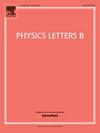强子量热计中出现的光子射流:大型强子对撞机中性长寿命粒子的新特征
IF 4.5
2区 物理与天体物理
Q1 ASTRONOMY & ASTROPHYSICS
引用次数: 0
摘要
我们提出了中性长寿命粒子(LLPs)的一种新的对撞机特征:强子量热计(HCAL)中出现的光子射流。当中性LLP在HCAL内衰变为光子时,就会产生电磁阵雨,而电磁量热计(ECAL)中没有相关的带电轨迹或能量沉积。为了证明这种方法的可行性,我们考虑了i型双希格斯双重态模型中的费米恐惧症希格斯玻色子hf作为代表性情景。在超轻状态下(mhf<1 GeV), hf通过环诱导过程只衰变成光子对,导致抑制宽度,因此寿命长。聚焦黄金通道pp→H±hf→W±hfhf,我们分析了一个hf在ECAL中衰减并表现为高度准直的光子射流(重建为单个光子),而另一个hf在HCAL内衰减并产生新兴光子射流的奇异最终态。通过详细的信号-背景分析,结合现实的探测器效应,通过快速模拟,我们证明了这种特征在HL-LHC中实现了与理论和实验约束一致的广泛参数空间区域的发现级灵敏度。虽然我们的研究重点是费米粒子希格斯粒子,但在HCAL中出现的光子喷射构成了一种广泛适用的、以前未被探索的策略,用于探测中性LLP衰变为光子,为在对撞机中搜索LLP开辟了一条新的途径。本文章由计算机程序翻译,如有差异,请以英文原文为准。
Emerging photon jets in the hadronic calorimeter: A novel signature of neutral long-lived particles at the LHC
We propose a novel collider signature for neutral long-lived particles (LLPs): the emerging photon jet in the hadronic calorimeter (HCAL). This signature arises when a neutral LLP decays into photons within the HCAL, producing an electromagnetic shower without associated charged tracks or energy deposits in the electromagnetic calorimeter (ECAL). To demonstrate the viability of this approach, we consider the fermiophobic Higgs boson in the Type-I two-Higgs-doublet model as a representative scenario. In the ultralight regime ( GeV), decays exclusively into a photon pair via loop-induced processes, resulting in a suppressed width and consequently a long lifetime. Focusing on the golden channel , we analyze the exotic final state in which one decays in the ECAL and appears as a highly collimated photon jet (reconstructed as a single photon), while the other decays within the HCAL, producing an emerging photon jet. Through a detailed signal-to-background analysis incorporating realistic detector effects via fast simulation, we demonstrate that this signature achieves discovery-level sensitivity at the HL-LHC across a broad region of parameter space consistent with theoretical and experimental constraints. While our study focuses on the fermiophobic Higgs, the emerging photon jet in the HCAL constitutes a broadly applicable and previously unexplored strategy for detecting neutral LLPs decaying into photons, opening a new avenue in LLP searches at colliders.
求助全文
通过发布文献求助,成功后即可免费获取论文全文。
去求助
来源期刊

Physics Letters B
物理-物理:综合
CiteScore
9.10
自引率
6.80%
发文量
647
审稿时长
3 months
期刊介绍:
Physics Letters B ensures the rapid publication of important new results in particle physics, nuclear physics and cosmology. Specialized editors are responsible for contributions in experimental nuclear physics, theoretical nuclear physics, experimental high-energy physics, theoretical high-energy physics, and astrophysics.
 求助内容:
求助内容: 应助结果提醒方式:
应助结果提醒方式:


